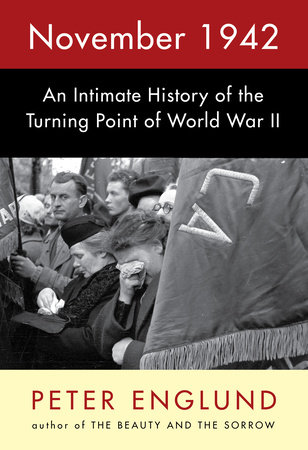November 1942: An Intimate History of the Turning Point of World War II
- By Peter Englund; translated by Peter Graves
- Knopf
- 496 pp.
- Reviewed by Larry Matthews
- January 2, 2024
An extraordinary chronicle of ordinary people caught up in battle.

There are thousands and thousands of books about World War II. Some are fiction. Some are scholarly. Yet rarely do they offer the kind of detailed global photograph of the conflict that Peter Englund produces in November 1942. Englund is a Swedish historian and journalist and a member of the Swedish Academy, which selects winners of the Nobel Prize. His research here is nothing short of astonishing.
It was in that month, November 1942, that the war finally turned against the Axis powers across a vast battlefield that stretched from Stalingrad to North Africa to Burma to China to Guadalcanal. Englund not only details the battles that raged, he also tells the personal stories of 39 men and women who were in those pivotal locales during that critical period. One of them was U.S. Army Lieutenant Charles Walker, who faced a determined Japanese force in hellish combat on Guadalcanal. Writes Englund of Walker’s experience:
“And they have already learned that the body odor of living Japanese soldiers differs from that of Americans. It’s not clear whether it’s their situation or fear, but after weeks crowded together in narrow trenches many of them find they can pick out the individual smell of their fellow soldiers. That can sometimes mean the difference between life and death.”
The British, for their part, were waging their own bloody battle in the air over Germany. Here, Englund looks through the eyes of RAF pilot John Bushby:
“He began counting, and then he realized that there were only two left of all the pilots and crewmen in 83 Squadron he started his service with in January. Bushby writes: ‘It had never come home to me as starkly as at that moment, and I had a feeling of near panic, of being trapped, suffocated by something which was closing in around me and which I was powerless to prevent.’”
The British were also in a desperate fight for control of Libya, battling Germans and Italians amid stifling desert heat. Although Italian soldier Caccia Dominioni was an experienced paratrooper, writes Englund, “There is no finesse here, no smart moves. It’s all about pounding away and seeing who can hold out longest.” Thus went the battle of el-Alamein, which the Allies eventually won.
The most gripping and heart-wrenching scenes recounted in the book are from Treblinka, one of the Nazi concentration camps where Jews were sent by the thousands to be slaughtered. “On this Monday, November 2, a train of cattle cars arrives at Treblinka,” writes Englund. “It contains 4,330 Jews from Siemiatycze, a small town in eastern Poland. They are all murdered before nightfall.” The details the author provides are the stuff of nightmares.
Englund’s research took him to old letters, reports, interviews, and anything else that could bring November 1942 into sharper focus. We meet women who suffer. Women who fight. Spies. Soldiers. Sailors. And even the 28-year-old Albert Camus, just becoming famous, dabbling in the French Resistance and seeking permission from the Germans to travel to Paris.
That autumn, too, the Germans and Soviets were locked in one of history’s bloodiest and most massive battles: Stalingrad, about which excellent books have been written (see Enemy at the Gates). “When the battle began, success was defined as capturing a district of the city; that was soon reduced to taking a street, then an individual building, and now a single floor, or a stairwell, or a room,” Englund explains. Losses on both sides were horrendous, in the hundreds of thousands:
“…people going mad, raving mad; of hunger; of diarrhea and exhaustion to the point of hallucination.”
The world was on fire during WWII; the level of misery was impossible to gauge. In a time-honored method of telling big stories by telling small ones, Englund introduces us to people who may be historical footnotes — fighters, workers, comfort women, housewives — but whose searing recollections humanize a world gone insane in a way grand, sweeping tomes cannot.
While reading, I found myself drawing parallels to what’s happening in the world today. It’s not on the same scale, of course, but even now cities are being bombed and the joy is being squeezed out of life for countless men, women, and children. November 1942 is a reminder of what can happen when the evil in the human spirit overwhelms our better angels. It’s not just a good book, it’s a great one, and it belongs on everyone’s shelves. Find a comfortable chair and settle in with Englund’s work for a long winter’s read. It’s well worth it.
Larry Matthews is the author of Take a Rifle from a Dead Man and other books.

